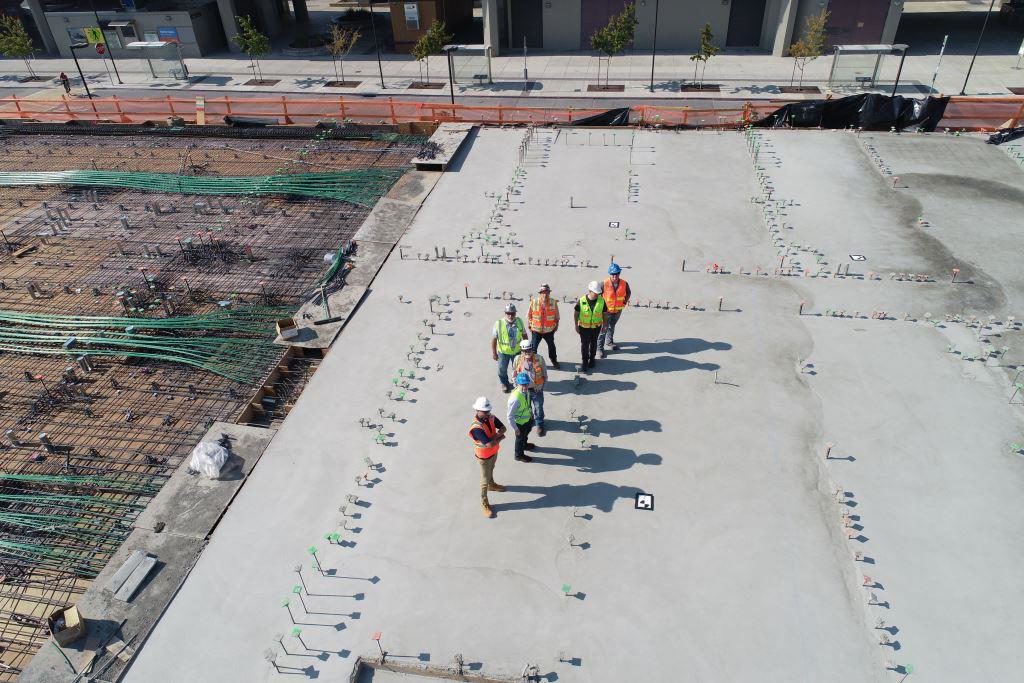Amin Terouhid, Ph.D., PE, PMP, VMA
Abstract
This article describes the value methodology, explains how this methodology can be used in various development phases of a construction project and identifies the benefits of value engineering and value analysis studies in various stages of a construction project. The construction process is typically divided into the five essential development phases of planning, conceptual design, detailed design, construction, and close-out. Value studies are conducted in each of these development phases with a slightly different set of objectives. This article will discuss the types of values studies that are performed in each phase and discuss some of the key considerations necessary to perform such studies.
Introduction
“The Value Methodology (VM) is a systematic process used by a multidisciplinary team, led by a qualified VM Facilitator, to improve the value of a project, product, process, service, or organization through the analysis of functions (SAVE International, 2020, p. 2).
The Code of Federal Regulations defines Value Engineering (VE) analysis as the “systematic process of reviewing and assessing a project by a multidisciplinary team not directly involved in
the planning and development phases of a specific project that follows the VE Job Plan and is conducted to provide recommendations for:
(1) Providing the needed functions, considering community and environmental commitments, safety, reliability, efficiency, and overall lifecycle cost (as defined in 23 U.S.C. 106(f)(2));
(2) Optimizing the value and quality of the project; and
(3) Reducing the time to develop and deliver the project.” (The Code of Federal Regulations (CFR): Title 23 CFR Part 627.3 Highways, 2020)
Although the value methodology (VM) is often referred to as value engineering, value analysis and value management, these terms are often used in a slightly different way. The term VA is typically used when the VM applies to an existing application (e.g., manufacturing or construction project) whereas VE applies the VM to a new project. Nevertheless, these terms overlap, and the use of more than one term might be appropriate in some cases. Therefore, the terms value methodology, value engineering, value analysis, and value management are often used interchangeably. Yet, no single term is universally accepted. The community of practitioners seems to struggle to use a consistent approach in using a single term. In this article, the term value methodology is used throughout for consistency. What is important to note, however, is that value improvement is the main focus irrespective of the specific term used.
Since enhancing the value of a project, product, process, service, or organization is central to value enhancement efforts, it is important to first define the term “value”. Value is typically defined as an “expression of the relationship between the performance of functions relative to the resources required to realize them” (SAVE International, 2020, p. 153) which is expressed as:
Value = (Function Performance) / Resources
The more we gain in equivalent money, usefulness, or a fair return on services, goods, or products while spending fewer resources, the more overall value is gained. A correct understanding of the term “function” is critical to the definition above. Function is the primary or intended purpose that a project or scope element aims to serve. In value studies, the value team can perform function analysis by:
- Assessing the functions of key project components and evaluating alternative solutions that satisfy functional requirements
- Appraising value-enhancing, cost-saving, and/or time-saving opportunities
Say a value team is investigating a highway project with certain elements such as a turn lane and a frontage road. To perform function analysis, the team can investigate how the turn lane can have the same function but in a way that the overall cost decreases. For example, the function of a turn lane in a highway project is to allow for shifting traffic to the left. In a highway project, a turn lane can serve the same function if the original concept remains unchanged, but the team shifts the westbound turn lane to the ramp further west to avoid the Right of Way acquisition. As another example, the function of a frontage road is to divert traffic. A frontage road may serve the same function if the team decides to re-use existing frontage roads in specific segments of the highway versus reconstructing them in their entirety.
In construction, the value methodology is used to improve a construction project by optimizing costs while maintaining or improving quality and performance. The use of value methodology has a wide range of benefits for construction projects. The key benefits include:
- Applying the value methodology facilitates reaching time and cost objectives,
- Assists in saving time and cost with assessing the project function and different alternatives, and
- Aids in improving the construction performance.
Various Development Phases of a Construction Project
The development phases of projects that follow a process-based approach are typically organized using the following steps (PMI, 2021, p. 171):
- Initiation: In this stage, a new project or a new phase of an existing project is defined. To achieve this objective, authorization is obtained to commence the project or phase.
- Planning is required to establish the scope of the project, refine the project objectives, and establish the course of action needed to achieve the project objectives.
- This stage aims to complete the scope of work established in the previous development state to meet the project requirements.
- Monitoring and controlling. These processes, which are performed concurrently within the execution, are needed to monitor, review, and control the work progress that is made to achieve project objectives. They help to evaluate the performance of the project team in completing the scope of work. Project monitoring and controlling help the project team to compare the project performance with what was planned to ensure deviations are identified and proper actions are taken to minimize deviations. The outcome of project monitoring and control is typically a series of action plans / corrective actions to better achieve the project objective.
- In the end, closing steps are taken to formally complete or close the project. The closing phase may involve different aspects/components. Examples include project document updates, final product transition, a final report, and organizational process asset updates. Some of the main activities during the closing phase include financial/payment closeout, releasing resources, documenting lessons learned, administrative closures and conducting project reviews.
The construction process, however, is often divided into a different set of steps as an organizing structure. They are typically divided into the following essential development phases:
- Planning,
- Conceptual design (as part of preconstruction),
- Detailed design,
- Construction, and
- Close-out.
Value studies are conducted in each of these development phases with a slightly different set of objectives. A typical value study is conducted according to a Job Plan which is a” sequential approach for applying the Value Methodology, consisting of the following eight phases: 1) Preparation, 2) Information, 3) Function Analysis, 4) Creativity, 5) Evaluation, 6) Development, 7) Presentation, 8) Implementation” (SAVE International, 2020, p. 153). Each value study aims to address each phase in the VE Job Plan; however, the level of analysis performed, and efforts spent in each VE Job Plan phase may be adjusted not only based on the needs of each project but also based on the needs of the project’s current development phase.
In the following section, the main focuses of value studies in each of the typical development phases of construction projects are identified and the details of such studies are discussed:
Value Studies in Various Development Phases of a Construction Project
It is important that value studies are conducted at the right times. To achieve this objective, the value team needs to be aware of the benefits of value studies in each of the development phases of a project, and determine what parts or types of studies can be performed in each stage. As noted in the VM Guide, “oftentimes projects are too far along in their development when a VM study is performed. A VM study performed for a project that is 95 percent designed, and nearly ready for construction will not fully realize the benefits of VM had the VM study been performed at the 10 – 15% design level” (SAVE International, 2020, p. 145).
In theory, value studies can be applied to any construction project irrespective of its current development phase. However, as noted above, the earlier these studies are performed, the more effective their outcomes are expected to be. Nevertheless, the main focuses of value studies in each of the typical development phases of construction projects are slightly different.
The main focuses of value studies in each of the following essential development phases of a construction project are described below:
1- Planning
The application of value studies starts during the planning phase of a construction project. During this phase, the scope of the project is established, project objectives are refined, and the course of action needed to achieve the project objectives is recognized. In this phase, the ability to influence changes in design is relatively high and the cost and effort needed to implement those changes are relatively low. Because the ability to influence changes in design is relatively high in the planning phase, value studies can be conducted with minimal concerns about incurring undue expenses for a redesign. Therefore, value studies conducted during the planning stage have a remarkable potential for enhancing value. The value study can bring a fresh outside view of alternate solutions from other similar projects (Cullen, 2021).
In the early stages of the planning phase, value scoping can be performed to determine the mission and direction of the value proposal. Such studies can establish the scope and mission of value studies. Once value scoping is delineated, value studies can start to be implemented. These efforts can help the project owner establish their requirements and define needs and expectations that value studies can satisfy.
2- Conceptual design
Conceptual design is characterized by a large number of design alternatives and a continuous, evolutionary change to the design which requires iterative cycles of idea generation and evaluation. In the early phases of conceptual design, the alternatives evaluation is performed to assess available possibilities and form a basis for design. In this phase, the design has not been frozen yet and design alternatives are being considered. Since the majority of budgetary costs will be committed by project sponsors once the design is frozen, many opportunities are still available during the conceptual design phase to influence the design and reduce or avoid unnecessary costs. The earlier in the design phase value studies are conducted, the greater the opportunities will be to reduce or avoid unnecessary costs. For instance, changing the geometry or boundaries of a highway is much easier in the early stages of the design work than changing them in the later stages of the design.
3- Detailed design
As previously noted, the design is evolved in the early stages of the design work. However, as the design is further developed, the design is solidified and it is ultimately frozen during the detailed design phase. Once the design is frozen, the final design is achieved. This design stage is characterized by the efforts focused on the preparation of final construction plans and detailed
specifications for the performance of construction work.
The detailed design phase is the phase in which most value studies are initiated when the design has at least made it to the schematic stage. Most public agencies require at least one value study to be conducted at the design stage on projects over a certain dollar amount. Value studies are often conducted after the completion of the design process. It is important to note, however, that such studies are preferred to be conducted before the design is complete to allow the design team to incorporate the option of using alternative materials and methods. The Federal Highway Administration (2021) defines VE analysis as a systematic process of review and analysis of a project, during the concept and design phases. According to SAVE International, “typically, 70 percent of costs are committed by the time the design is frozen” (SAVE International, 2020, p. 146). According to Anderson et al. (2007), “value engineering is most successful when it is performed early in project development. A value engineering study should be performed within the first 25—30% of the design effort prior to selecting the final design alternative” (p. A-165).
The use of the value methodology mindset throughout the design phase can help the project team benefit from the advantages of value studies while maintaining project requirements. In this phase, formal value studies are typically conducted in value workshops by an experienced, multi-disciplinary team of subject matter experts (SMEs) prior to freezing the design. Formal value studies are typically conducted by a team led by someone highly experienced in leading value studies and workshops, usually a Certified Value Specialist (CVS) who ensures the value methodology process is properly used throughout the study. The workshop typically takes three to four days but may take longer depending on the project size and specific needs of the project and/or expectations of project stakeholders. The time and effort spent on the workshop have an insignificant impact on the final project schedule and redesign costs.
Typically, in the initial phases of detailed design, a team of independent SMEs, a value methodology facilitator, and often project stakeholders is formed to attend a workshop to conduct value studies in accordance with a Value Engineering (VE) Job Plan. As previously noted, Job plan is a systematic action plan for performing value studies and documenting the outcomes in an organized manner.
To follow the action plan delineated in the VE Job Plan, the following phases are completed one after another (SAVE International, 2020):
- Preparation: in this phase, preparatory activities are performed to reach common ground among the members of the value team while facilitating team building.
- Information: project information including scope, objectives, project commitments, and constraints are collected and shared among the members of the value team. In this phase, value team members aim to identify various aspects of the project which are most likely to yield value improvement. To achieve this objective, the team members will utilize a variety of tools and techniques including cost engineering techniques, FAST (Function Analysis Systems Technique), expert judgement and information gathering techniques to identify opportunities for value improvement. These opportunities will be the focus areas of the VE/VA team going forward.
- Function Analysis: the project is analyzed to understand the required functions of various scope elements. To achieve this objective, the value team collaborate and achieve consensus as to the needed functions. This phase serves as an essential component of each value study, and aims to evaluate each selected element (i.e., opportunity for value improvement) to determine its basic and secondary functions. It also aims to assess the costs of the element and the way the costs are distributed among its functions.
In this phase, the FAST diagramming technique is used extensively to perform function analysis. This analysis allows a multi-discipline team to collaborate and achieve consensus as to the needed functions (basic and secondary functions along with other functions such as all-time functions), in preparation for generating innovative ideas about how best to achieve the intended functions. In this phase, the team’s collaboration and interactions play central role in identifying functions and assessing value improvement opportunities. The team members collaborate and achieve consensus as to the needed functions in preparation for generating innovative ideas about how best to achieve the intended functions. In this phase, the team’s collaboration and interactions play central role in identifying functions and assessing value improvement opportunities.
- Creativity: the value team generates ideas on ways to accomplish the required functions while enhancing the project’s performance, quality, and/or lower project costs. In this phase, the facilitator encourages the members of the value team to use brainstorming techniques to think creatively to generate ideas. The intent is for them to individually and collectively, come up with creative ideas and creatively identify value improvement opportunities by accounting for the functions identified in the previous phase.
- Evaluation: Evaluate VE recommendations and select feasible ideas for development. During this phase, the value team aims to reduce the list of ideas to those most reasonable and feasible by analyzing advantages and disadvantages of each idea. To achieve this objective, a variety of techniques are used to evaluate and prioritize ideas. Examples of these techniques include weighting techniques and life-cycle cost assessment techniques. The facilitator plays a key role in facilitation discussions among the team members to assess the viability and reasonableness of value improvement ideas.
- Development: Develop the selected alternatives into fully supported recommendations. The phase involves the advancement of the VE/VA team’s ideas to the level of value improvement recommendations. The selected recommendations will ultimately be presented as the outcomes of the value study. In this phase, the value team uses a variety of techniques to further develop the ideas. Examples include:
- Diagramming,
- Sketching,
- Perfuming calculations,
- Preparing graphics,
- Furnishing reports,
- Reaching out to other specialists or stakeholders to obtain supplemental information, and
- Present the selected recommendations as to the outcomes of the value study.
In doing so, each team member will contribute to a written report. In general, the value study team will also prepare and deliver a brief presentation at the completion of the study to present the recommendations and share their findings with the executive decision team and other project stakeholders.
- Presentation: In this phase, the outcome of the development phase will be presented on the final study day to project stakeholders and decision-makers who were not directly engaged in value studies. In this phase, the members of the value team collaborate and interact with each other to develop the agreed-upon recommendations for presentation to the project stakeholders and the executive decision team. Team members will present value improvement recommendations in their areas of practice or expertise. They present value improvement recommendations they personally assessed and developed during the study. This information will be incorporated into the final report.
- Implementation: This phase focuses on determining the disposition of the value recommendation and validating its impact on the value of the project.
The above-noted steps outlined the main phases of a Job Plan that needs to be followed like an action plan to achieve the objectives of a value study. The following section explains how value studies might be used during the construction phase.
4- Construction
During the construction phase, value studies may still be conducted in different forms. The need for conducting value studies arises during the construction phase primarily in the following two situations:
- Often a value study performed in the previous development phases of a construction project identifies that further studies should be performed on certain elements of the project scope of work once the work has further progressed. For example, a new construction material is often identified by a value study in the conceptual design phase as a material that potentially results in cost savings. However, such decisions cannot often be finalized unless further investigation is performed during the construction phase to ensure the new material has the characteristics that the design requires.
- Often a construction contractor identifies elements of the scope of work that can be improved if a value study is performed. In some cases, performing such studies is among the contractual requirements. Because of its potential benefits, some government agencies or project owners have made value studies a required component of construction projects. For example, incentive clauses of some construction contracts often allow for sharing cost savings between a contractor and project owner if the contractor performs a value study and find creative ideas for alternative ways to accomplish the required functions of a work element. Examples of these contract clauses include the value engineering incentive clauses and the value program requirements clauses.
Value engineering incentive clauses are utilized for soliciting contractor or vendor inputs. To do so, their inputs as obtained in the form of a change proposal using a mechanism that is referred to as a value engineering change proposal (VECP). The VM Guide defines VECP as a “change submitted by a contractor, pursuant to a contract provision, to improve the value of the project or product under contract. VECPs are a vehicle to incentivize contractor innovation and are commonly used in public sector contracts” (SAVE International, 2020, p. 139)
The Code of Federal Regulations defines VECP as a “construction contract change proposal submitted by the construction contractor based on a VECP provision in the contract. These proposals may improve the project’s performance, value and/or quality, lower construction costs, or shorten the delivery time, while considering their impacts on the project’s overall life-cycle
cost and other applicable factors.” (The Code of Federal Regulations (CFR): Title 23 CFR Part 627.3 Highways, 2020) On some projects, the bidders can suggest alternative means and methods and design features to meet the goals of the project at a lesser cost and/or time of performance.
Cost savings resulting from approved and implemented VECPs are typically shared (i.e., typically a 50-50 sharing rule is used unless the contract parties agree otherwise) between the project owner and contractor. According to SAVE International, an “acceptable VECP must
meet two tests: it must require a change in some contract provision, and it must reduce the contract price. A complete VECP should contain information similar to a VM
proposal” (SAVE International, 2020, p. 148).
Value program requirements clauses are slightly different. Such clauses aim to ensure continuous consideration of potential innovations and improvements over the course of the project. Value program requirements clauses require the construction contractor to conduct value studies that are going to be funded by the owner as a separate line item of work under the contract. They may still allow for incentive sharing for each proposal but typically the contractor’s proportion of cost savings is smaller than under an incentive provision because the cost of such studies is typically paid by the project owner.
5- Close-out
During the closeout phase, the outcomes of value studies performed over the course of the project are documented and lessons learned are recorded. In addition, organizational process assets are updated based on historical records of value studies, and administrative closures are taken place.
Conclusion
This article described the value methodology, explained how this methodology can be used in various development phases of a construction project, and identified the benefits of value studies in various stages of a construction project. It was explained that the construction process, is typically divided into the five essential development phases of planning, conceptual design, detailed design, construction, and close-out. Value studies are conducted in each of these development phases with a slightly different set of objectives. A typical value study is conducted according to a Job Plan, and each value study aims to address each phase in the VE Job Plan; however, the level of analysis performed, and efforts spent in each VE Job Plan phase may be adjusted not only based on the needs of each project but also based on the needs of the project’s current development phase.
List of References
Anderson, S. D., Molenaar, K. R., & Schexnayder, C. J. (2007). Guidance for cost estimation and management for highway projects during planning, programming, and preconstruction (Vol. 574). Transportation Research Board.
Cullen, S. W. (2021). Value Engineering. Whole Building Design Guide. https://www.wbdg.org/resources/value-engineering
FHWA. (2021). The Value Engineering (VE) Process and Job Plan. https://www.fhwa.dot.gov/ve/veproc.cfm
PMI. (2021). The Guide to the Project Management Body of Knowledge (PMBOK® Guide) – Seventh Edition. Project Management Institute.
SAVE International. (2020). VM Guide: A Guide to the Value Methodology Body of Knowledge.
The Code of Federal Regulations (CFR): Title 23 CFR Part 627.3 Highways. (2020). Office of the Federal Register, National Archives and Records Administration. https://www.govinfo.gov/content/pkg/CFR-2020-title23-vol1/pdf/CFR-2020-title23-vol1.pdf











